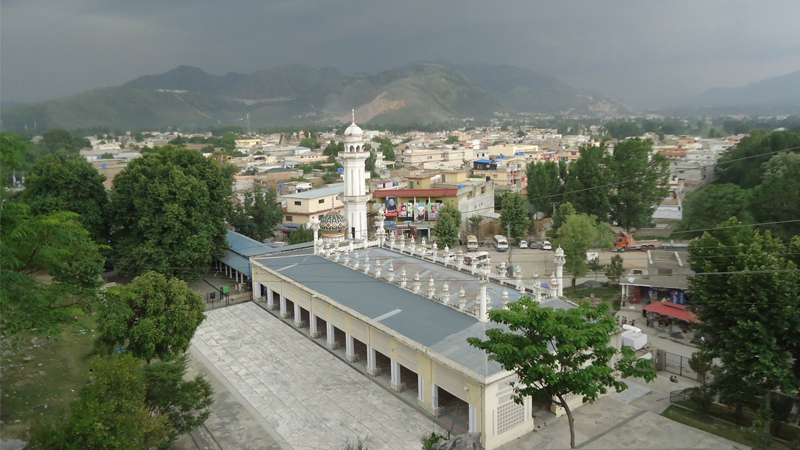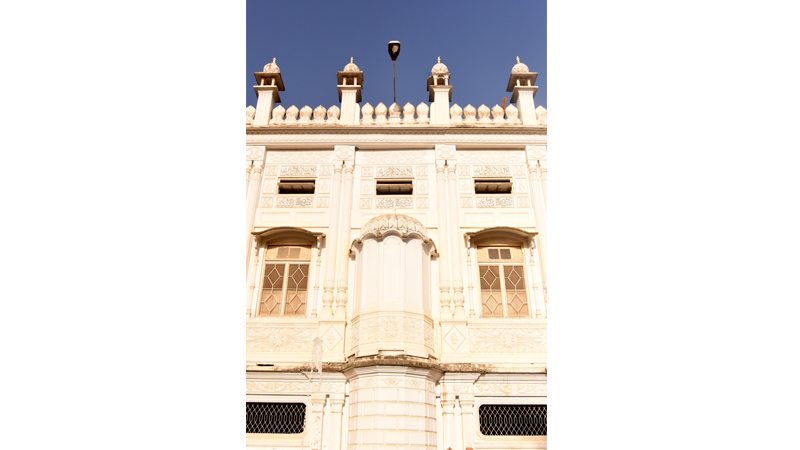 Amidst the hustle and bustle of vibrant bazaars, colourful shops and small tea stalls, I came across the striking and magical Ilyasi Masjid in Abbotabad.
Amidst the hustle and bustle of vibrant bazaars, colourful shops and small tea stalls, I came across the striking and magical Ilyasi Masjid in Abbotabad.
For a moment I could not take my eyes off the mosque with its white glittering magnificence, architectural beauty and imposing structure. I am sure that if you would have been there, you too would have been enchanted by it’s mesmerising, mystic and spell binding aura.
I was in a trance, a feeling that I had never experienced before. When I entered the mosque through a small gateway, I saw people sitting around with their eyes fixed on its facade, admiring its beauty and praying to God Almighty.
The air was full of a sense of peace and tranquility, soothing the people who had come there to offer their prayers. As I strolled towards the front area of the mosque I was captivated by an unidentifiable force. Located there was a pond with fountains as high as hills. A small part held the ablution area.
Before me stood the glittering white snowy structure of the mosque. It seemed as if the entire facade was covered with snow like the high peaks of the surrounding areas. The exterior of the mosque has exquisite carvings that artists seem to have made out of sheer respect and love.
Water from the ancient natural spring of Ilyasi Masjid is said to possess healing powers
Actually I was in search of something else there, something which my mother had told me to look for. A natural water spring which had been there since ages.
As I made my way up the staircase, I saw a stream of water coming out of a pillar-like structure. I stopped there for a moment and asked the women filling bottles from the water if this was the ancient natural spring of Ilyasi Masjid? When they answered in the affirmative I was awe stunned and at the same time delighted that I had finally got to witness the wonder about which my mother told me when I was a child. Trust me I had goose bumps!
I stopped there and felt the sweet and fragrant spring water for a moment and after ablution with the same went upstairs. There was a huge prayer chamber with a veranda outside it. The upper architecture of the mosque was even more stunning. One could sit there for days admiring the sheer beauty of the architecture, carvings and design, all white in colour.
A man standing there told me that this was the men’ prayer chamber and gestured me a little ahead at another corner where the women prayer chamber is located. I went to the women prayer chamber and offered my namaz. As I said my namaz I felt as if I was in another world, a place out of this universe, where there is only peace, harmony, composure, calmness and presence of unseen souls.
There was a sense of mystery in the air, as if mystic souls were roaming around, whispering the names of Allah and praising him for the wonders He had created in this world.
Before me was the glittering white snowy structure of the mosque. It seemed as if the entire facade was covered with snow like the high peaks of the surrounding areas
Now let me tell you an interesting thing about this mosque and its natural spring. My elders and mother had told me that the pure water running inside this mosque could cure any skin, muscle and bone disease. The water is as pure as glass and sparkles like a diamond. Many people have their own way of telling stories related to the Ilyasi Masjid Spring and it has inspired numerous myths and folklores.
In these modern times nobody believes in folklores any longer, but trust me I have experienced the spring’s healing powers.
The spring’s water is supplied to the entire mosque. To my chagrin I was unable to see the place where the spring originated from as according to locals and mosque caretakers the location has been closed to the public.
What I liked most from my visit to the mosque was that there is no restriction on photography. The Ilyasi Masjid is famous for being a tourist spot and located on its each side, are shops selling delicious pakoras and chapli kebab. Tourists milling about were enjoying these delectable treats.
The Ilyasi Masjid is located in Nawan Shehar, Abbottabad District of Khyber Pakhtunkhwa, Pakistan.
There is an interesting historic story about Nawan Shehar. Its former name was ‘Urasa’ often called Wadi-e-Orash (Orash valley). Nawan Shehar village was established in 1723 and it remained a village during the British
Raj. The area was developed after independence from the British rule.
The town was built and named Nawan Shehar meaning “the new city”. According to historic references and from what I learnt from the locals, Sikhs constructed a fort near the Ilyasi Masjid. Although, there is no sign of that fort now, the area is still known as Mohallah Qilla (fort).
The locals also narrated to me stories of various Sikh battles. They also told me that during the Second World War 63 local villagers had gone and fought for the British Army.
 Spreading over five kanals, the Ilyasi Masjid was built somewhere around 1927-1932. It was constructed over a stream of water that flowed from the nearby mountain. Aged locals informed me that the mosque was built before partition and its magnificence and opulence has only increased with time due to the devotion and spiritual attachment of the people. I was also told that before the mosque’s construction began Christians wanted to build a church there instead but the locals had resisted the plan.
Spreading over five kanals, the Ilyasi Masjid was built somewhere around 1927-1932. It was constructed over a stream of water that flowed from the nearby mountain. Aged locals informed me that the mosque was built before partition and its magnificence and opulence has only increased with time due to the devotion and spiritual attachment of the people. I was also told that before the mosque’s construction began Christians wanted to build a church there instead but the locals had resisted the plan.
The mosque and its surrounding area is controlled and owned by the Jadoon family. The ice-cold,fresh mineral water sparkling like crystal has been flowing here since the mosque was constructed. I think it is an incredible gift of nature to the mankind. Blessings like these remind me of Surah-Ar-Rahman’s Ayat that when translated states: “How many blessings of your Lord will you then deny?”
The Ilyasi Masjid is the oldest and largest mosque in Abbottabad and people come here to seek spiritual solace and admire its beauty. In my opinion, the mosque’s magnificent architecture ranks it among Pakistan’s most beautiful and unique buildings.
Published in Daily Times, August 31st 2018.